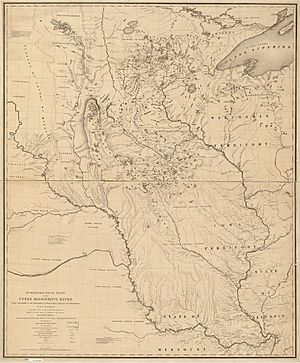Mdewakanton facts for kids
The Mdewakanton (also called Mdewakantonwan) are an important group of the Dakota (also known as Sioux) nation. Their name means "Dwellers of the Spirit Lake." Their original home was around Mille Lacs Lake in central Minnesota. This lake is called Mde Wákhaŋ or Bde Wákhaŋ in the Dakota language, meaning "Spirit Lake."
The Mdewakanton, along with the Wahpekute, are part of the Upper Council of the Dakota. Today, their descendants live in federally recognized tribes in the United States, in Minnesota, South Dakota, and Nebraska. They also live in First Nations communities in Manitoba, Canada.
Contents
A Look Back: Mdewakanton History
Long ago, the Mdewakanton were seen as a leading group among the Očhéthi Šakówiŋ, which means "The Seven Council Fires." This was a big alliance of seven Sioux tribes. Their ancestors may have moved to the upper Midwest from areas further south and east. Over time, they traveled through what is now Ohio and into Wisconsin.
By the 1600s, the Santee Dakota, including the Mdewakanton, faced competition from other Native American groups like the Ojibwe. This led them to move further west into what is now Minnesota.
In 1687, a French explorer named Greysolon du Lhut visited a large village of the "Nadouecioux." This village was on the southwestern shore of Mde Wakan, which is now Mille Lacs Lake. The name Santee first referred only to the Mdewakanton. Later, it included the Wahpekute and then all the Eastern Dakota tribes.
Land Treaties and Challenges
In 1837, the Mdewakantonwan made a deal with the U.S. government. This was part of an "Indian Removal" policy. They agreed to give up their lands east of the Mississippi River. In return, they were promised almost one million dollars.
However, the payment was not given all at once. The treaty said that $300,000 would be invested. The Mdewakanton were supposed to get at least five percent of this investment each year, forever. A part of this money, up to one-third, could be used as the President decided. This "discretionary fund" was worth $5,000 a year. It became a big problem. The government said it was for education, but very little of this money was spent on the Mdewakanton for 15 years.
Mdewakanton Communities in the U.S.
The Mdewakanton traditionally lived in separate villages. Each village had its own leaders. Today, their descendants live on different reservations. Each reservation has its own tribal government. In the United States, the Mdewakanton are part of the larger Dakota and Yankton-Yanktonai groups.
South Dakota
- Crow Creek Sioux Tribe on Crow Creek Indian Reservation (includes Mdewakanton, Yankton, and some Lower Yanktonai)
- Flandreau Santee Sioux Tribe on Flandreau Indian Reservation (includes Mdewakanton, Wahpekute, and Wahpeton)
Minnesota
- Upper Sioux Community – Pejuhutazizi Oyate on Upper Sioux Indian Reservation (includes Sisseton, Wahpeton, and Mdewakanton)
- Lower Sioux Indian Community on Lower Sioux Indian Reservation (includes Mdewakanton and Wahpekute)
- Shakopee Mdewakanton Sioux Community on Shakopee-Mdewakanton Indian Reservation (includes Mdewakanton and Wahpekute)
- Prairie Island Indian Community on Prairie Island Indian Community (includes Mdewakanton and Wahpekute)
- Mendota Mdewakanton Dakota Community (a Mdewakanton-only group, not yet federally recognized)
Some Mdewakanton in Minnesota also live with Ojibwe people on the Mille Lacs Reservation. They are part of the Mille Lacs Band of Ojibwe.
Nebraska
- Santee Sioux Nation on Santee Sioux Reservation (includes Mdewakanton and Wahpekute)
Mdewakanton Communities in Canada
In Canada, Mdewakanton descendants live with other Dakota and Yanktonai groups. They are part of various band governments.
Manitoba
- Sioux Valley Dakota Nation on Sioux Valley Dakota Nation Reserve and Fishing Station 62A Reserve (includes Sisseton, Wahpeton, and some Mdewakanton and Wahpekute)
- Birdtail Sioux First Nation on Birdtail Creek 57 Reserve, Birdtail Hay Lands 57A Reserve, and Fishing Station 62A Reserve (includes Mdewakanton, Wahpekute, and some Yanktonai)
Some Mdewakanton may also live within the White Bear First Nations. This group mainly includes members of the Plains Cree, Western Saulteaux, and Assiniboine peoples.
Historic Mdewakanton Groups
The Mdewakanton were made up of several smaller groups or divisions. Here are some of the main ones:
- Wakpaatonwedan division ("Those who dwell on the creek"): This was one of the two early main Mdewakanton divisions.
- Real Wakpaatonwedan: Lived along Rice Creek in Minnesota.
- Kiyuska ("Rule breakers"): Lived below Lake Pepin. Their main village, Keoxa, was near today's Winona, Minnesota. Chiefs named Wapasha led them.
- Titonwan or Tintaotonwe ("Village of the prairie"): This was the largest Mdewakanton village. It was south of the Minnesota River, near today's Shakopee, Minnesota. Chiefs named Shakopee led them.
- Matantonwan division ("Village of the great lake which empties into a small one"): This was the other early main Mdewakanton division.
- Real Matantonwan: Lived at the mouth of the Minnesota River.
- Pinisha or Pinichon: Lived at Nine Mile Creek on the Minnesota River. Named after Chief Pinisha, "Good Road."
- Kaposia or Kapozha kodozapuwa ("Those who travel with light burdens"): Their village was closest to Fort Snelling on the Mississippi River. Famous chief Taoyateduta (Little Crow) led them.
- Mahpiyamaza or Makhpiyamaza: Their village was near today's Hastings, Minnesota. Named after Chief Makhpiyamaza, "Iron Cloud."
- Mahpiyawichasta: Lived near today's Chain of Lakes in Minneapolis. Their band was named after their war chief Marpiyawicasta, "Man of the Clouds."
Today, only a few of these historic bands, like the Kiyuska, Pinisha, and some Matantonwan groups, still exist as organized communities.


